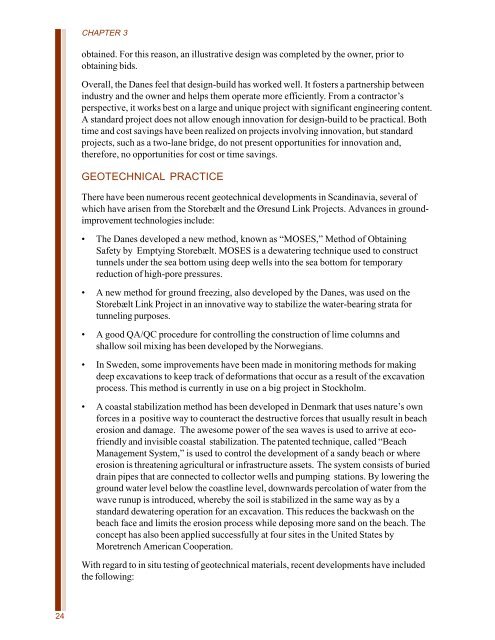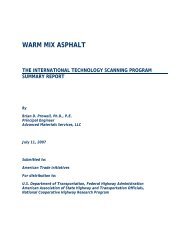geotechnical engineering practices in canada - the Office of ...
geotechnical engineering practices in canada - the Office of ...
geotechnical engineering practices in canada - the Office of ...
Create successful ePaper yourself
Turn your PDF publications into a flip-book with our unique Google optimized e-Paper software.
24<br />
CHAPTER 3<br />
obta<strong>in</strong>ed. For this reason, an illustrative design was completed by <strong>the</strong> owner, prior to<br />
obta<strong>in</strong><strong>in</strong>g bids.<br />
Overall, <strong>the</strong> Danes feel that design-build has worked well. It fosters a partnership between<br />
<strong>in</strong>dustry and <strong>the</strong> owner and helps <strong>the</strong>m operate more efficiently. From a contractor’s<br />
perspective, it works best on a large and unique project with significant <strong>eng<strong>in</strong>eer<strong>in</strong>g</strong> content.<br />
A standard project does not allow enough <strong>in</strong>novation for design-build to be practical. Both<br />
time and cost sav<strong>in</strong>gs have been realized on projects <strong>in</strong>volv<strong>in</strong>g <strong>in</strong>novation, but standard<br />
projects, such as a two-lane bridge, do not present opportunities for <strong>in</strong>novation and,<br />
<strong>the</strong>refore, no opportunities for cost or time sav<strong>in</strong>gs.<br />
GEOTECHNICAL PRACTICE<br />
There have been numerous recent <strong>geotechnical</strong> developments <strong>in</strong> Scand<strong>in</strong>avia, several <strong>of</strong><br />
which have arisen from <strong>the</strong> Storebælt and <strong>the</strong> Øresund L<strong>in</strong>k Projects. Advances <strong>in</strong> groundimprovement<br />
technologies <strong>in</strong>clude:<br />
• The Danes developed a new method, known as “MOSES,” Method <strong>of</strong> Obta<strong>in</strong><strong>in</strong>g<br />
Safety by Empty<strong>in</strong>g Storebælt. MOSES is a dewater<strong>in</strong>g technique used to construct<br />
tunnels under <strong>the</strong> sea bottom us<strong>in</strong>g deep wells <strong>in</strong>to <strong>the</strong> sea bottom for temporary<br />
reduction <strong>of</strong> high-pore pressures.<br />
• A new method for ground freez<strong>in</strong>g, also developed by <strong>the</strong> Danes, was used on <strong>the</strong><br />
Storebælt L<strong>in</strong>k Project <strong>in</strong> an <strong>in</strong>novative way to stabilize <strong>the</strong> water-bear<strong>in</strong>g strata for<br />
tunnel<strong>in</strong>g purposes.<br />
• A good QA/QC procedure for controll<strong>in</strong>g <strong>the</strong> construction <strong>of</strong> lime columns and<br />
shallow soil mix<strong>in</strong>g has been developed by <strong>the</strong> Norwegians.<br />
• In Sweden, some improvements have been made <strong>in</strong> monitor<strong>in</strong>g methods for mak<strong>in</strong>g<br />
deep excavations to keep track <strong>of</strong> deformations that occur as a result <strong>of</strong> <strong>the</strong> excavation<br />
process. This method is currently <strong>in</strong> use on a big project <strong>in</strong> Stockholm.<br />
• A coastal stabilization method has been developed <strong>in</strong> Denmark that uses nature’s own<br />
forces <strong>in</strong> a positive way to counteract <strong>the</strong> destructive forces that usually result <strong>in</strong> beach<br />
erosion and damage. The awesome power <strong>of</strong> <strong>the</strong> sea waves is used to arrive at ec<strong>of</strong>riendly<br />
and <strong>in</strong>visible coastal stabilization. The patented technique, called “Beach<br />
Management System,” is used to control <strong>the</strong> development <strong>of</strong> a sandy beach or where<br />
erosion is threaten<strong>in</strong>g agricultural or <strong>in</strong>frastructure assets. The system consists <strong>of</strong> buried<br />
dra<strong>in</strong> pipes that are connected to collector wells and pump<strong>in</strong>g stations. By lower<strong>in</strong>g <strong>the</strong><br />
ground water level below <strong>the</strong> coastl<strong>in</strong>e level, downwards percolation <strong>of</strong> water from <strong>the</strong><br />
wave runup is <strong>in</strong>troduced, whereby <strong>the</strong> soil is stabilized <strong>in</strong> <strong>the</strong> same way as by a<br />
standard dewater<strong>in</strong>g operation for an excavation. This reduces <strong>the</strong> backwash on <strong>the</strong><br />
beach face and limits <strong>the</strong> erosion process while depos<strong>in</strong>g more sand on <strong>the</strong> beach. The<br />
concept has also been applied successfully at four sites <strong>in</strong> <strong>the</strong> United States by<br />
Moretrench American Cooperation.<br />
With regard to <strong>in</strong> situ test<strong>in</strong>g <strong>of</strong> <strong>geotechnical</strong> materials, recent developments have <strong>in</strong>cluded<br />
<strong>the</strong> follow<strong>in</strong>g:







